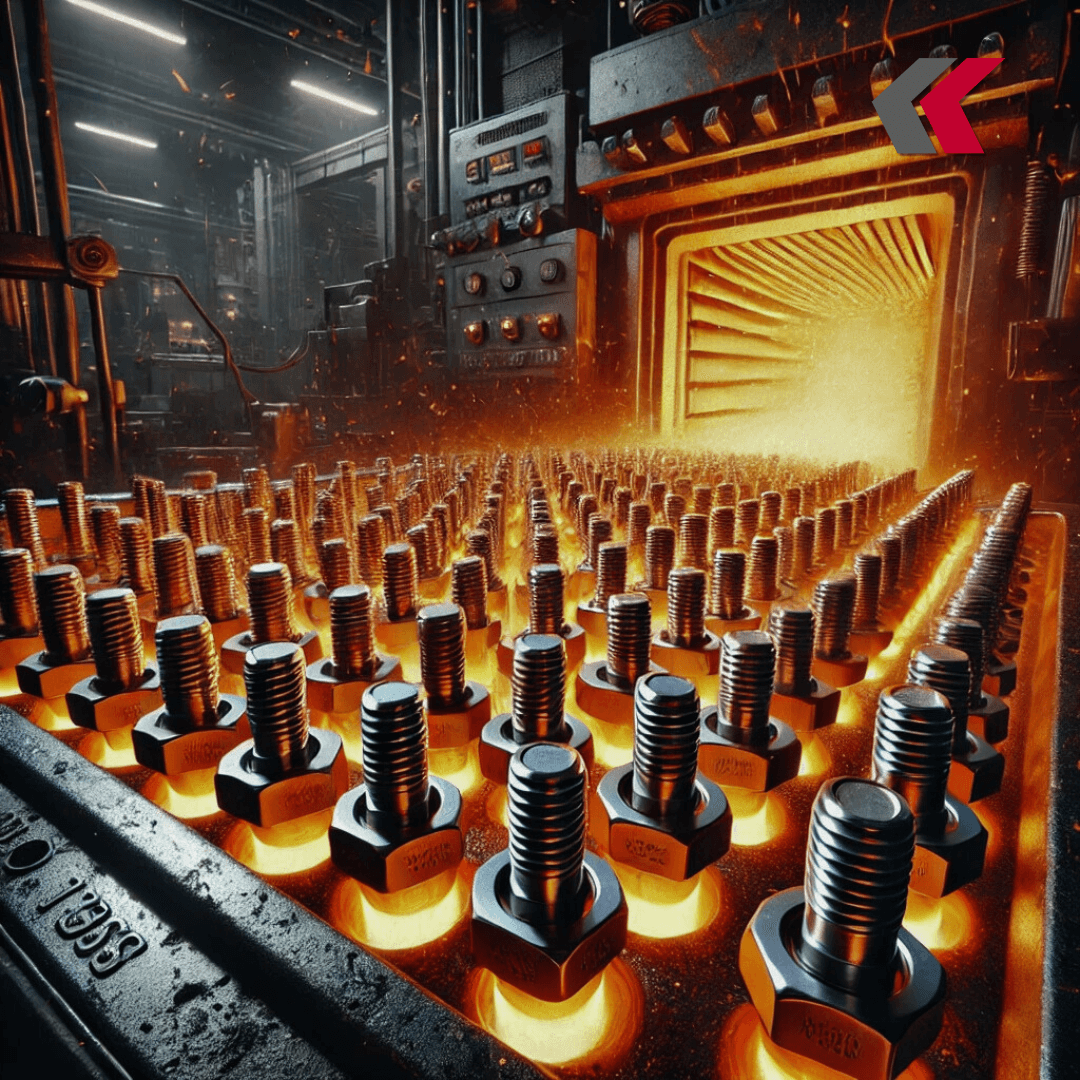Heat treatment is a controlled process of heating and cooling metals to alter their physical and sometimes chemical properties. Heat treatment is especially significant in stainless steel manufacturing – it allows engineers to optimize hardness,

Heat treatment is a controlled process of heating and cooling metals to alter their physical and sometimes chemical properties. Heat treatment is especially significant in stainless steel manufacturing – it allows engineers to optimize hardness, strength, ductility, and corrosion resistance to meet specific application requirements. Manufacturers can tailor stainless steel’s performance for anything from delicate medical instruments to heavy-duty industrial fasteners by carefully selecting a heat treatment method. This is where Brikksen’s expertise as a master distributor of stainless steel fasteners comes into play. With over 15 years in the industry, Brikksen provides high-quality fasteners that rely on proper heat treatment to achieve strength and durability. This blog will explore key heat treatment processes (like annealing, hardening, and stress relieving), understand their benefits, and see how they impact stainless steel – particularly in fastener applications.
Understanding Heat Treatment
Heat treatment encompasses a range of techniques that use controlled heating and cooling to modify a metal’s internal structure (microstructure) and thus its properties. In essence, heating stainless steel to a target temperature causes changes in its crystal structure; subsequent cooling (whether slow or rapid) “freezes” the steel’s microstructure into a new configuration. This can relieve internal stresses, increase hardness, or improve ductility, depending on the process. For example, heating steel into its austenitic phase and then cooling it rapidly can create martensite, a hard phase, whereas slow cooling might produce softer phases that improve workability. The interplay of temperature and cooling rate is crucial: even the same steel can become soft and formable or hard and strong, simply by altering the heat treatment cycle.
Inside a heat-treating furnace at ~1800°F (982°C). Stainless steel components are heated to modify their microstructure and properties through controlled cooling.
In stainless steels, heat treatment must be carefully managed to maintain corrosion resistance. Stainless alloys contain chromium and carbon; certain heat treatments (like solution annealing) dissolve potentially harmful carbide precipitates to prevent corrosion, while others (like precipitation hardening) intentionally form particles that strengthen the alloy. The bottom line is that heat treatment is a powerful tool to tune material properties without changing the shape of the part. Next, we’ll delve into specific processes – annealing, hardening (quenching and tempering), and stress relieving – and see how each one works.
Heat Treatment Processes Explained
Annealing
Annealing is a heat treatment process that softens stainless steel, increases its ductility, and relieves internal stresses. In an annealing cycle, the steel is heated to a specific high temperature (often into its austenitic phase), held at that temperature (so that the structure fully adjusts), and then cooled very slowly (usually in the furnace or in air). This slow cooling allows the microstructure to re-form in a relaxed state, resulting in a softer, more ductile material. Annealing is commonly used after cold working or machining operations. For instance, stainless steel sheet metal that has been stamped or bent may become work-hardened and prone to cracking; annealing will restore its ductility so it can be further formed without issues. Annealing also relieves residual stresses from welding, helping prevent distortion or stress-corrosion cracking in service. The key outcomes of annealing are: reduced hardness, improved elongation (flexibility), and removal of residual stress within the steel’s grains.
Hardening (Quenching and Tempering)
Hardening of stainless steel typically involves heating the steel to a high temperature and then rapidly cooling it (a process known as quenching) to “freeze” a hard microstructure in place. Not all stainless steels can be hardened by heat treatment – this mainly applies to martensitic grades (like 410 or 420 stainless) and precipitation-hardening grades (like 17-4 PH). For a hardenable grade, the steel is heated into its austenitic phase (often ~950–1100°C depending on grade) and then quenched in oil, water, or air. The rapid cooling transforms the structure into martensite, which is very hard but brittle. To counter the brittleness, a subsequent heat treatment called tempering is done: the steel is reheated to a moderate temperature (e.g. a few hundred °C) and then cooled, which reduces brittleness while retaining most of the hardness. The result is a much harder and stronger stainless steel, with a trade-off of lower ductility.
In practice, a hardened stainless fastener (say a 410 stainless bolt) can have significantly higher strength than the same bolt in an annealed condition. Manufacturers commonly harden 410 by heating to ~800°C+ and oil-quenching, then tempering, to achieve a high Rockwell hardness (often up to ~HRC 35) for use in screws and bolts. This is essential for applications like pumps, valves, or engines where wear resistance and high strength are needed. It’s worth noting that austenitic stainless steels (like 304 or 316) cannot be hardened by heat treatment – quenching them does not create martensite. Those grades are instead hardened by cold working. However, martensitic and precipitation-hardening stainless steels respond very well to quenching/tempering, achieving a strong, tough structure ideal for high-stress uses.
Stress Relieving
Stress relieving is a heat treatment used to reduce residual internal stresses in stainless steel without significantly changing its structure or hardness. During processes like machining, cutting, or welding, stainless steel can accumulate localized stresses. If left in place, these stresses might lead to distortion, cracking, or dimensional changes later (especially if the part is subjected to further heat or load). To stress relieve, the steel is heated to a moderate temperature (typically well below the steel’s transformation range – for stainless often around 550–650°C) and held for an hour or two. It is then cooled slowly, usually in air. This treatment allows the metal’s crystal lattice to relax slightly, releasing locked-in stresses. Importantly, the cooling is slow and the temperature is not high enough to form new phases, so the steel’s hardness, strength, and microstructure remain essentially unchanged. The benefit is improved dimensional stability and reduced risk of cracking or warping down the line.
Stress relieving is often done after rough machining and before final finishing of precision components. For example, a large stainless steel flange that’s been welded may be stress relieved to prevent it from warping over time. In the fastener world, if a component like a custom-machined shaft or a complex threaded part has tight tolerances, stress relieving can ensure it stays true to shape. Unlike annealing, stress relieving does not soften the metal dramatically – it simply provides peace of mind that internal tensions are minimized.
Comparison of Heat Treatment Processes
To summarize the differences between these processes, the table below highlights how annealing, hardening, and stress relieving each affect stainless steel properties:
Process | Method (Heating & Cooling) | Effect on Hardness | Effect on Ductility | Internal Stress |
Annealing | Heat to high temp, slow cool (in furnace/air) | Decreases (steel softens) | Increases (more ductile) | Relieved (stresses reduced) |
Hardening | Heat to high temp, rapid quench (oil/water/air) | Greatly increases (steel hardens) | Decreases (brittle if untempered) | Introduced (new stresses form, tempered after) |
Stress Relief | Heat to moderate temp, slow cool | No significant change | No significant change (slight increase possible) | Relieved (stresses reduced) |
Table: Heat treatment processes for stainless steel and their general effects on material properties.
Benefits of Heat Treatment
Applying the appropriate heat treatment to stainless steel yields several key benefits that enhance performance and extend the life of components:
• Increased Hardness and Wear Resistance: Hardening treatments (with quenching) produce a harder surface or overall structure, which means stainless steel parts can better resist wear, abrasion, and surface damage. This is crucial for high-stress applications like bearings, pump shafts, or cutting tools that see constant friction. For example, a heat-treated stainless steel gear will last longer under load than the same gear in a softer condition.
• Enhanced Strength and Toughness: Heat treatments can significantly boost the tensile and yield strength of stainless steel. By refining the microstructure (through processes like quenching and tempering or precipitation hardening), the metal becomes capable of withstanding higher stresses without deforming. Importantly, follow-up processes like tempering ensure that the increased strength doesn’t come at the expense of brittleness, thereby improving toughness (the ability to absorb energy without fracturing). This balance is vital in applications like aerospace components, where materials must be strong yet reliable under shock loading.
• Improved Corrosion Resistance: Some heat treatments can improve corrosion resistance of steel. For instance, solution annealing of austenitic stainless (heating to very high temperature followed by rapid cooling) dissolves chromium carbides and prevents sensitization, thereby maintaining the alloy’s corrosion resistance. Quenching certain stainless steels can also improve corrosion resistance by locking elements in solution . Additionally, modern surface-hardening techniques (like low-temperature nitriding or boronizing) can create hard surface layers without depleting chromium, resulting in surfaces that are both wear-resistant and still stainless. The outcome is a component that not only is stronger but can also better withstand harsh environments (chemicals, saltwater, etc.).
• Dimensional Stability and Reduced Distortion: Heat treatments like stress relieving ensure that parts retain their shape during manufacturing and service. By eliminating internal stresses, subsequent machining or temperature changes are less likely to cause the metal to “move.” This is a major benefit for precision fasteners and components with tight tolerances. A stress-relieved stainless steel fixture, for example, will experience fewer dimensional changes over time, which is critical in maintaining alignment in an assembly.
Overall, heat treatment extends the lifespan and reliability of stainless steel parts by tailoring properties to their service conditions. A heat-treated stainless steel bolt in a high-temperature, high-load scenario will perform better and longer than a non-heat-treated one, because its properties have been optimized for that role.
Impact on Material Properties
What’s happening inside the metal during heat treatment? On a microscopic level, the heat treatment process changes the arrangement of atoms and phases in stainless. In annealing, for example, grains recrystallize into a more uniform, strain-free structure. Any micro-cracks or distortions from prior processing get healed as the crystal lattice reforms. This is why annealed stainless steel has lower hardness and higher ductility – its microstructure is essentially “reset” to a relaxed state.
During hardening, the steel’s phase changes dramatically. Taking a martensitic stainless steel from high heat to a rapid quench traps carbon atoms in a strained position within the iron lattice, creating martensite, which is much harder than the original phase. The trade-off is that this structure is less orderly and has internal stresses, hence the need for tempering to slightly soften and stabilize it. Tempering allows some microstructure decomposition (e.g., some martensite turning into tempered martensite or ferrite plus carbides) which reduces brittleness but keeps the steel significantly harder than before hardening. The net result: heat-treated (quenched & tempered) stainless steel vs. non-heat-treated can exhibit double or more the tensile strength. For example, Type 410 in the annealed condition might have a tensile strength around 500–700 MPa, whereas after hardening and tempering it can exceed 1000 MPa, making it suitable for load-bearing screws and springs.
Heat treatment can also influence properties like magnetism and electrical conductivity, but in stainless steels the focus is usually on mechanical and corrosion properties. One interesting point: austenitic stainless steels (300 series) remain essentially unchanged in hardness by heat treatment – their impact comes from processes like annealing for stress relief or to restore corrosion resistance (by dissolving carbides). In contrast, martensitic and precipitation-hardening stainless steels owe their high-performance to heat treatment, achieving properties that raw stainless steel wouldn’t have. Precipitation hardening grades, such as 17-4 PH, are a great example: after solution treating and aging, they form tiny precipitates (particles) throughout the microstructure that block dislocation movement, yielding high strength. A 17-4 PH bolt can be up to four times stronger than a standard 316 stainless bolt , while still retaining comparable corrosion resistance – a direct result of the careful aging heat treatment it undergoes .
In summary, heat treatment directly alters stainless steel’s microstructure, which in turn dictates properties like hardness, strength, ductility, and corrosion behavior. Heat-treated and non-heat-treated stainless steels of the same grade can behave very differently under load. The appropriate heat treatment ensures the material’s performance aligns with its intended use, whether that’s resisting deformation, absorbing impact, or avoiding corrosion.
Heat Treatment and Fasteners
When it comes to fasteners – bolts, nuts, screws, and other hardware – heat treatment can mean the difference between success and failure in critical applications. Brikksen, as a master distributor of stainless steel fasteners, understands the importance of delivering products that have the right heat-treated properties for the job. Why are heat-treated stainless fasteners essential for high-strength applications? Consider an example: a heavy machinery assembly that requires bolts to hold against extreme vibration and load. Standard 18-8 (304 stainless) bolts might be very corrosion-resistant, but they are relatively low in strength (cannot be heat-hardened) and may stretch or gall under such stress. However, a heat-treated 410 stainless steel bolt can provide much higher strength and hardness, enabling it to withstand the forces without yielding. Heat-treated fasteners are thus often found in engines, turbines, pressure vessels, and structural connections – anywhere that demands both strength and durability.
Brikksen supplies common fastener grades that undergo heat treatment for enhanced performance. One example is Grade 410 stainless screws and self-tapping fasteners, which are typically hardened and tempered. In the hardened state, 410 stainless can achieve a Rockwell hardness of around C35, making it ideal for cutting threads into harder materials. These fasteners are used in applications like pump housings, aerospace components, or chemical processing equipment where you need a combination of corrosion resistance and high hardness. Another example is 17-4 PH stainless fasteners (AISI 630). Brikksen’s 17-4 PH bolts and nuts are supplied in conditions like H900 or H1150 (which are specific aging heat treatments) to reach tensile strengths on the order of 1400 MPa (roughly 4 times stronger than non-hardenable 316 stainless) . Such fasteners are common in the aerospace and military sectors, as well as oil & gas equipment, where both strength and corrosion resistance are critical.
Quality is paramount – a poorly executed heat treatment can lead to problems like brittleness (if over-hardened without proper tempering) or loss of corrosion resistance (if austenitic stainless is held in the wrong temperature range causing carbide precipitation). Brikksen works closely with manufacturers to ensure that stainless fasteners are heat treated to the correct specifications, and that they meet industry standards for hardness and strength. Every batch of high-strength stainless fasteners undergoes rigorous quality control, including hardness testing and microstructure verification, to confirm that the heat treatment has achieved the desired results. As a distributor that “only sells to distributors,” Brikksen adds value by providing technical insights on fastener selection – for instance, advising when a heat-treated grade is necessary for a given application, or explaining the benefits of a certain heat treatment (like stress-relieved threads to prevent loosening under stress).
From Brikksen’s perspective, heat treatment is not an afterthought but a key part of the fastener supply chain. It enables them to deliver bolts and screws that perform reliably in the field. Distributors and end-users can trust that a stainless fastener from Brikksen – whether it’s a small self-drilling screw or a large heavy hex bolt – has been processed for optimum properties. This reliability in turn helps prevent failures in service, reduce maintenance (since heat-treated fasteners resist wear and galling), and ultimately supports safer, longer-lasting assemblies for Brikksen’s customers.
Assortment of stainless steel screws. Certain fasteners (e.g. martensitic or precipitation-hardening stainless) are heat treated to increase strength and hardness for demanding applications.
In the fastener world, using the right grade with the right heat treatment can solve many engineering challenges. For example, if galling (thread seizing) is a concern with stainless nuts and bolts, one solution is using a heat-treated nut of higher hardness than the bolt. Brikksen’s catalog includes such combinations to ensure ease of installation and removal. Furthermore, for high-temperature applications, heat-treated fasteners (like 17-4 PH or 660 stainless, also known as A-286) retain strength where others would soften. Brikksen’s role as a master distributor is not just to sell stainless fasteners, but to educate and supply the best-fit product – and heat treatment is a big part of what makes a fastener the “best fit” for a job.
Conclusion & Key Takeaways
Heat treatment is an indispensable step in unlocking the full potential of stainless. By carefully heating and cooling stainless alloys, manufacturers can achieve a spectrum of properties – from ultra-soft and ductile for forming, to ultra-hard and strong for load-bearing uses. In this post, we covered how annealing makes stainless steel more workable and relieves stress, how hardening (quenching and tempering) gives certain stainless grades the high strength needed for demanding tasks, and how stress relieving fine-tunes components for stability. We also saw real-world examples: heat-treated stainless steels are crucial in automotive gears, aerospace parts, medical tools, food processing equipment, and oil & gas infrastructure, to name a few. These treatments improve mechanical performance and often the longevity of parts in harsh conditions.
For stainless steel fasteners, heat treatment often marks the difference between a standard part and a high-performance one. Key takeaways for fastener selection: if you need a bolt that won’t stretch or shear in a high-stress situation, look for one made from a heat-treatable grade (martensitic or PH stainless) and ensure it’s been properly hardened and tempered. If a component has been heavily machined or welded, consider stress relieving to avoid future distortions. Always balance hardness with toughness – overly hard without tempering can be a risk. This is where Brikksen’s expertise as a master distributor truly matters. They ensure that the stainless fasteners they supply have been heat treated correctly to deliver the promised performance. Brikksen stands behind the quality of its fasteners, providing distributors and manufacturers confidence that each nut and bolt will perform as expected in service.
In conclusion, heat treatment matters for stainless steel fasteners and components because it directly impacts their strength, durability, and reliability. Whether it’s preventing a flange from warping or giving a bolt the backbone to hold an aircraft together, heat treatment is the quiet hero in metallurgy. Brikksen’s commitment to quality and knowledge in this domain helps customers get the right fasteners – ones that are not just made of stainless steel, but made of better stainless steel through the science of heat treatment. Selecting heat-treated stainless fasteners when appropriate ensures optimal performance and safety, giving peace of mind that your assembly will hold up under pressure, time, and the elements.








